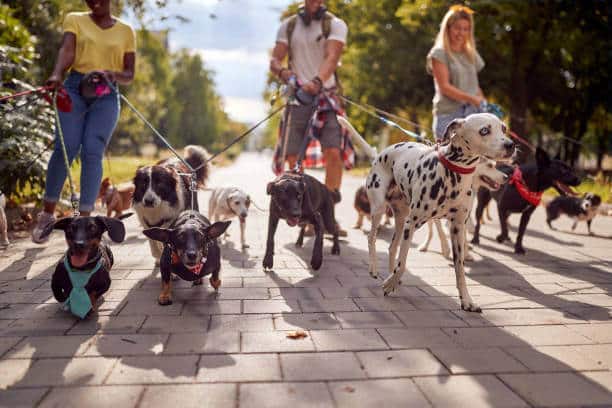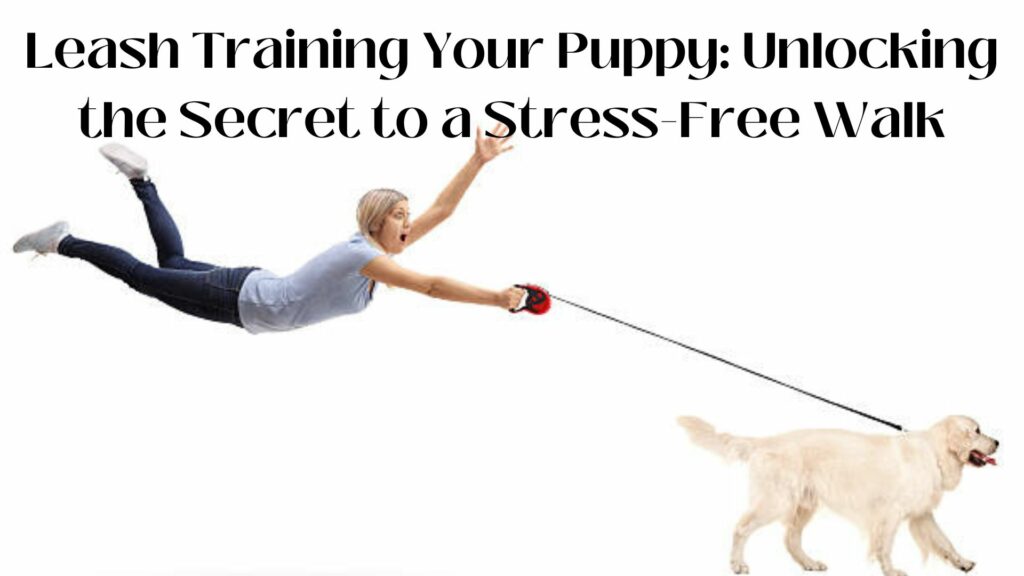Hey there! If you’re training your puppy, a leash is one of the most important tools you’ll need. It might seem like an obvious piece of equipment, but it’s a crucial part of the training process.
Using a leash can help keep your puppy safe, prevent them from running off, and ensure they don’t get into dangerous situations. It can also give you more control over your puppy’s movements and make training sessions more effective.
Think of the leash as a way to guide and communicate with your puppy while still allowing them to explore and have fun.
So, whether you’re teaching your puppy basic obedience commands, leash manners, or socialization skills, a leash is an essential tool for training your puppy.
This article will discuss everything you need to know about choosing the best leash for training your puppy. We’ll cover the different types of leashes and materials available and give you tips for selecting the right leash for your specific puppy and training needs.
We’ll also discuss the importance of positive reinforcement training techniques and how to incorporate them into your leash training sessions. By the end of this article, you’ll better understand how to use a leash to unleash your puppy’s potential and set them up for success in all aspects of its training. So, let’s dive in!
Types of Leashes for Training Your Puppy
When it comes to choosing a leash for training your puppy, there are several different types to consider. The most common types of leashes are standard, retractable, and slip leashes.
Standard Leash Nylon

Price At Time Of Publish – $10
Standard Leash: Leather

Price At Time Of Publish – $21
Standard leashes are the most basic type of leash and are typically made of nylon or leather. They come in various lengths, but the standard size is about 6 feet long. This type of leash is ideal for basic obedience training and leash manners, as it provides enough control over your puppy’s movements while still allowing them to move around freely. One of the drawbacks of standard leashes is that they don’t give your puppy much room to explore, which can be frustrating for some dogs.
Retractable Leashes

Price At Time Of Publish – $20
Retractable leashes, on the other hand, allow your puppy to roam further and have more freedom. They have a button that can be used to adjust the length of the leash, which can be handy for training activities that require more space. However, retractable leashes can be challenging to control and dangerous in certain situations, such as around other dogs or in high-traffic areas.
Slip Leashes

Price At Time Of Publish – $12
Slip leashes, also known as slip leads, are made of rope or nylon and are designed to tighten around your puppy’s neck when pulled. They are ideal for training activities that require quick corrections, such as leash manners or heel training. However, slip leashes should be used cautiously, as they can harm your puppy’s neck if not used properly.
When choosing a leash for training your puppy, it’s essential to consider the advantages and disadvantages of each type and select one that works best for your specific training goals and your puppy’s temperament. By choosing the right leash, you can make training your puppy more effective and enjoyable for both you and your furry friend!
What Leash Length Is Best For Training Your Puppy?
Regarding leash length for puppy training, there’s no one-size-fits-all answer. The ideal leash length can vary depending on your puppy’s breed, size, temperament, and the specific training activity you’re working on.
Most trainers generally recommend a leash that is around 6 feet long for standard training activities like obedience training and leash manners. This length provides enough control over your puppy’s movements without being too restrictive. It also allows your puppy enough room to explore and move around while still keeping them close enough to you for safety and control.
A longer leash may be more appropriate for activities requiring more space, such as recall training or agility training. Retractable leashes can be useful for these activities, as they allow your puppy to move around more freely while giving you some control over their movements.
On the other hand, a shorter leash may be more suitable for activities requiring more control, such as heel training. A 4-5 feet long leash can help keep your puppy close to your side and make it easier to communicate with them during training.
Ultimately, the ideal leash length for training your puppy will depend on various factors. It’s important to choose a leash that is comfortable for both you and your puppy, and that allows you to accomplish your training goals effectively. So, consider your puppy’s needs and temperament, and experiment with different leash lengths until you find the one that works best for you both.
Materials for Puppy Training Leashes
The two most commonly used materials for puppy training leashes are nylon and leather. Here’s a comparison of the benefits and drawbacks of each material and how they can affect training outcomes:
Nylon leashes are the most popular type of leash and are known for being affordable, durable, and lightweight. They come in various colors and designs, making them popular among fashion-conscious puppy parents. Nylon leashes are also easy to clean, which can be beneficial if your puppy likes to get dirty during training sessions. One downside of nylon leashes is that they can be prone to fraying over time, making them less effective for training activities requiring quick movements.
Leather leashes are also popular for puppy training, thanks to their durability and classic look. They are comfortable to hold and can provide a better grip than nylon leashes, which can be helpful for activities that require more control. Leather leashes are also less likely to tangle or twist, making them easier to handle during training. However, leather leashes can be more expensive than nylon leashes, requiring more maintenance to keep them in good condition.
Ultimately, the material you choose for your puppy’s training leash will depend on your personal preference and your puppy’s training needs. A leather leash may be a better choice if your puppy is prone to pulling or jumping, as it provides more control. If you’re looking for an affordable and easy-to-clean option, a nylon leash may be better. Whichever material you choose, make sure it’s comfortable for you to hold and easy for your puppy to handle. A comfortable leash can make training sessions more enjoyable and productive for both you and your furry friend!

Choosing the Right Leash for Training Your Puppy
When choosing a leash for your puppy’s training, several factors must be considered to ensure you get the best fit for your puppy. Here are some key things to keep in mind:
- Puppy size: Your puppy’s size can significantly impact the type of leash you choose. For instance, a smaller puppy may do better with a lighter leash, while a larger, stronger puppy may require a sturdier leash that can withstand more pulling or jumping.
- Puppy temperament: Different puppies have different personalities and temperaments. If your puppy is high-energy and excitable, you may need a leash that provides more control, such as a slip lead. However, a standard leash may be sufficient if your puppy is calm and well-behaved.
- Training goals: The type of training you’re doing with your puppy can also influence your leash choice. For example, a standard leash may be best if you’re working on basic obedience training. However, if you’re teaching your puppy to walk calmly on a leash, a shorter, thicker leash may be more effective.
- Material: The material of the leash can also be important, as it can affect comfort and durability. Leather leashes are generally more durable and comfortable to hold, while nylon leashes are lightweight and easy to clean.
- Your own comfort: Finally, choosing a comfortable leash for you to hold is important. If the leash is too heavy or too light, it may be difficult to control your puppy effectively.
By considering these factors, you can choose a comfortable and effective leash for both you and your puppy, helping you achieve your training goals more easily. Remember, the right leash can make a big difference in your puppy’s training success!
related article – a guide to leash training a dog or puppy
Dogs must be trained. That is important for your safety and that of your dog. You can’t forget the squirrels your dog might chase if you don’t. Leash training is crucial for dogs and puppies. All dogs have a prey drive that can cause them to run off and get lost.
Tips For Choosing The Best Leash
Selecting a comfortable leash for both you and your puppy is crucial for successful training. Here are some tips to help you find a leash that works for both of you:
- Consider the weight of the leash: A heavy leash can be uncomfortable for both you and your puppy, so look for a leash that is lightweight but sturdy.
- Choose a comfortable handle: Look for a leash with a handle that feels comfortable in your hand. It should be easy to grip and not too rough or abrasive.
- Check the length of the leash: As we mentioned earlier, the ideal length of a leash can depend on your puppy’s size and temperament. A too-short leash can be uncomfortable for your puppy, while a too-long leash can be difficult to control.
- Think about the material: Choose a leash made of a material that feels comfortable for your puppy’s neck and your hand. Leather and nylon are the most common materials, but other options are also available.
- Consider the hardware: The hardware on the leash, such as the clip and D-ring, should be sturdy and reliable. Ensure it is easy to attach and detach from your puppy’s collar.
- Test the leash before buying: It’s a good idea to test it before purchasing it. Hold it in your hand and imagine walking your puppy with it to see if it feels comfortable and easy to handle.
Considering these tips, you can choose a comfortable leash for both you and your puppy and make training sessions more enjoyable for everyone involved. Happy training!
Unleashing Your Puppy’s Potential with Positive Training Techniques
Positive training methods are becoming increasingly popular among puppy owners, and for a good reason. These methods focus on reinforcing good behavior through positive reinforcement rather than punishing bad behavior. Here are some tips for incorporating positive training methods into your puppy’s leash training:
- Reward good behavior: Use treats or praise to reward your puppy when they exhibit good leash manners, such as walking calmly beside you or not pulling on the leash.
- Avoid punishment: Punishing your puppy for bad behavior can be counterproductive and cause fear or anxiety. Instead, redirect their attention to a positive behavior, and reward them when they exhibit it.
- Use a clicker: Clicker training is a popular method of positive reinforcement training involving using a clicker to signal your puppy when they have done something correctly. This can be a powerful tool for leash training, allowing you to reinforce good behavior in real time.
- Be patient: Positive training methods can take time to work, so be patient and consistent with your training. It may take several sessions for your puppy to understand what you’re asking of them.
- Use positive language: When communicating with your puppy during training, use positive language and a cheerful tone of voice. This can help them associate training with positive experiences and make them more likely to cooperate.
By incorporating positive training methods into your puppy’s leash training, you can build a stronger bond with your furry friend and set them up for long-term success in all aspects of their training. Remember, training your puppy should be a fun and rewarding experience for both you and your puppy!
Related Article – Leash Training Your Puppy: Unlocking The Secrets To A Stress Free walk!
Leash training is a must for any pup owner, as it teaches your pup how to behave while walking on a leash. Is your puppy giving you a hard time on walks? Does your pup always seem to be pulling you in the wrong direction or not paying attention to you? If so, then leash … Read More >>

Help Your Puppy To Learn & Grow
Positive reinforcement is a powerful tool for training your puppy and can help them learn and grow healthily and positively. Here are some benefits of using positive reinforcement in your puppy’s training:
- Encourages good behavior: Positive reinforcement focuses on rewarding good behavior, which encourages your puppy to repeat that behavior in the future. This can be especially effective in leash training, as it helps your puppy understand what you expect of them.
- Builds confidence: Puppies that are trained using positive reinforcement are more likely to feel confident and secure in their interactions with their owners and other dogs. This can help them develop positive social skills and reduce anxiety or fear.
- Strengthens the bond between owner and puppy: Positive reinforcement involves using praise, treats, and other rewards to communicate with your puppy. This can help strengthen your bond with your furry friend and create a positive association with training.
- Can improve problem behavior: Positive reinforcement can effectively address problem behavior, such as pulling on the leash or jumping on people. By rewarding good behavior and redirecting your puppy’s attention to positive actions, you can help them overcome these challenges.
- Creates a positive training environment: Training your puppy using positive reinforcement creates a safe training environment free from fear or anxiety. This can help your puppy learn more quickly and make training sessions more enjoyable for everyone involved.
Overall, using positive reinforcement in your puppy’s training is a powerful way to help them learn and grow healthily and positively. By incorporating these methods into your leash training, you can build a strong and lasting bond with your furry friend that will benefit both of you for years to come.
Training Your Puppy Conclusion
Recap:
- A leash is an essential tool for training your puppy, providing safety and control
- Different types of leashes, such as standard, retractable, and slip, have advantages and disadvantages
- Leash length, material, and comfort are important factors to consider when selecting a leash for training your puppy
- Positive reinforcement training methods are beneficial for your puppy’s training, encouraging good behavior and building confidence
- Using a clicker and rewarding good behavior are effective ways to incorporate positive reinforcement into your leash training
Final thoughts:
When selecting a leash for training your puppy, consider its size, temperament, and training goals. Choose a comfortable leash for both you and your puppy, and use positive reinforcement techniques to build a strong bond and encourage good behavior. With patience, consistency, and a little bit of humor, you can set your puppy up for a lifetime of success.
Why did the puppy bring toilet paper to the party? Because he was a party pooper!
My name is Mark and I currently live in Australia. I am passionate about educating Doggie parents and helping you to make the best possible decisions to help your dog live a long, happy and healthy life. Remember… Owning a dog should be FUN, not a chore! “Dogs do speak, but only to those who know how to listen” – Orhan Pamuk
Check Our Popular Posts Here






